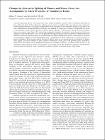| dc.contributor.author | WOLFE, KENNETH | |
| dc.date | 2005 | en |
| dc.date.accessioned | 2009-04-15T17:11:38Z | |
| dc.date.available | 2009-04-15T17:11:38Z | |
| dc.date.issued | 2005 | |
| dc.date.submitted | 2005 | en |
| dc.identifier.citation | Cusack, B. P., Wolfe, K. H. `Changes in alternative splicing of human and mouse genes are accompanied by faster evolution of constitutive exons? in Molecular Biology and Evolution, 22, (11), 2005, pp 2198-2208 | en |
| dc.identifier.other | Y | en |
| dc.identifier.other | Y | |
| dc.identifier.uri | http://hdl.handle.net/2262/29226 | |
| dc.description | PUBLISHED | en |
| dc.description.abstract | Alternative splicing is known to be an important source of protein sequence variation, but its evolutionary impact has not been explored in detail. Studying alternative splicing requires extensive sampling of the transcriptome, but new data sets based on expressed sequence tags aligned to chromosomes make it possible to study alternative splicing on a genome-wide scale. Although genes showing alternative splicing by exon skipping are conserved as compared to the genome as a whole, we find that genes where structural differences between human and mouse result in genome-specific alternatively spliced exons in one species show almost 60% greater nonsynonymous divergence in constitutive exons than genes where exon skipping is conserved. This effect is also seen for genes showing species-specific patterns of alternative splicing where gene structure is conserved. Our observations are not attributable to an inherent difference in rate of evolution between these two sets of proteins or to differences with respect to predictors of evolutionary rate such as expression level, tissue specificity, or genetic redundancy. Where genome-specific alternatively spliced exons are seen in mammals, the vast majority of skipped exons appear to be recent additions to gene structures. Furthermore, among genes with genome-specific alternatively spliced exons, the degree of nonsynonymous divergence in constitutive sequence is a function of the frequency of incorporation of these alternative exons into transcripts. These results suggest that alterations in alternative splicing pattern can have knock-on effects in terms of accelerated sequence evolution in constant regions of the protein. | en |
| dc.format.extent | 205998 bytes | |
| dc.format.extent | 2198-2208 | en |
| dc.format.mimetype | application/pdf | |
| dc.language.iso | en | en |
| dc.publisher | Oxford University Press | en |
| dc.relation.ispartofseries | Molecular Biology and Evolution | en |
| dc.relation.ispartofseries | 22 | en |
| dc.relation.ispartofseries | 11 | en |
| dc.rights | Y | en |
| dc.subject | alternative splicing | en |
| dc.subject | constitutive exons | en |
| dc.subject | exon skipping | en |
| dc.subject | nonsynonymous rates | en |
| dc.subject | selective constraint | en |
| dc.title | Changes in alternative splicing of human and mouse genes are accompanied by faster evolution of constitutive exons | en |
| dc.type | Journal Article | en |
| dc.contributor.sponsor | Science Foundation Ireland | |
| dc.type.supercollection | scholarly_publications | en |
| dc.type.supercollection | refereed_publications | en |
| dc.identifier.peoplefinderurl | http://people.tcd.ie/khwolfe | |
| dc.identifier.rssinternalid | 35973 | |
| dc.identifier.rssuri | http://dx.doi.org/10.1093/molbev/msi218 | |




